Last updated: September 30, 2024
Article
Mussel-Building with the Appalachian Highlands Network: Science and Snorkeling to Protect Imperiled Freshwater Mussels
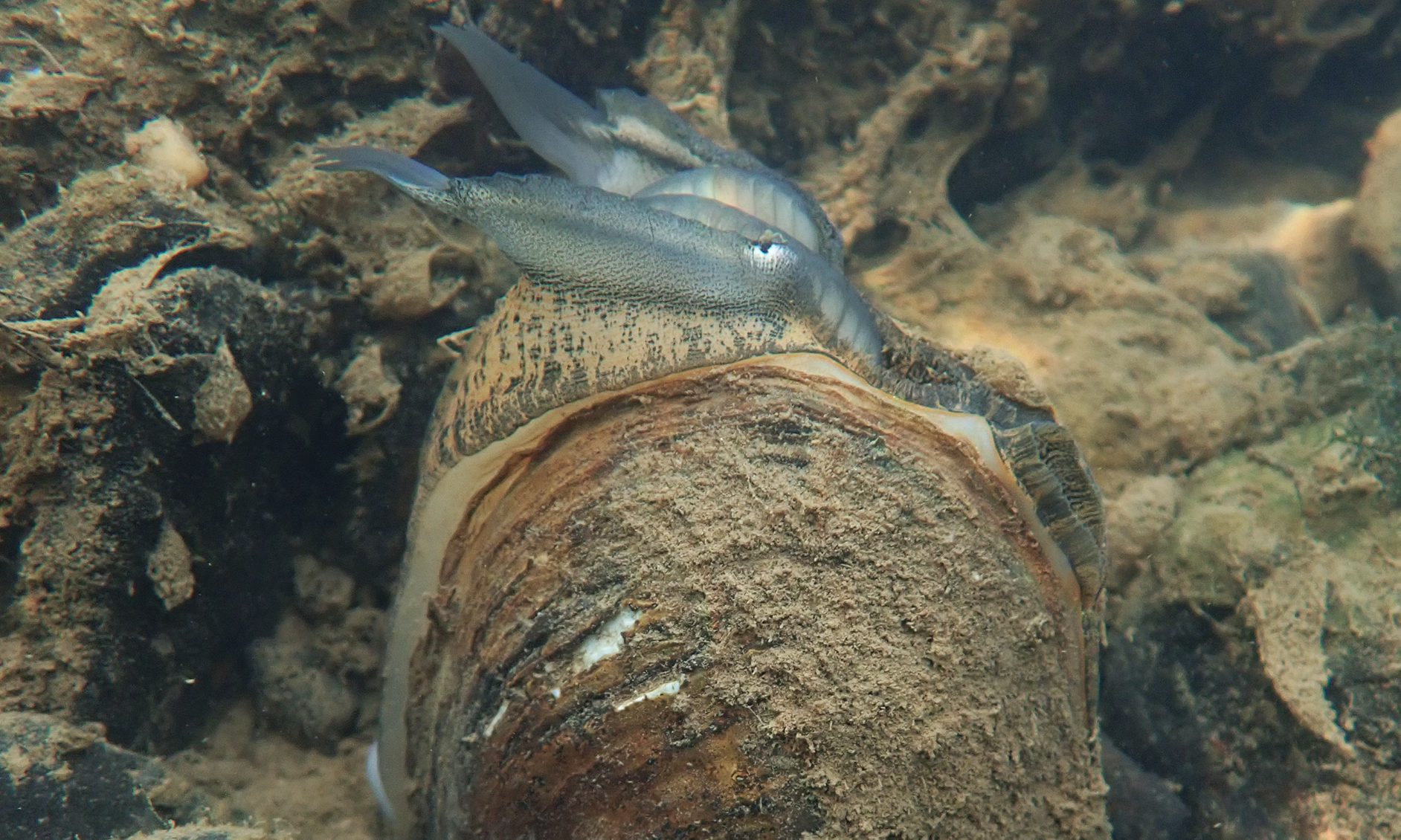
© Monte McGregor
How would you describe what you see in this photo? At first glance, it may look like a couple of fish scanning a streambed. But actually, those “fish” are an extension of the rock below—and that’s not really a rock. It’s a freshwater mussel.
Freshwater Mussels: A Vital Resource Under Threat
Freshwater mussels’ skills of deceit are just the beginning of their amazing story. Even though they spend most of their lives in one place, these animals have outsized impacts on their surroundings. They help clean the water they live in, cycle nutrients, and provide food and habitat for other organisms. Unfortunately, freshwater mussels are also one of the most imperiled groups of organisms on the planet1. Even at historic hotspots for mussel diversity, numbers are not what they once were. A century-long decline of mussel populations extends even into modern protected areas like Big South Fork National River and Recreation Area (NRRA) and Obed Wild and Scenic River (WSR). In response, National Park Service (NPS) scientists from the Appalachian Highlands Network are gathering information about the long-term health of mussel populations and participating in projects to ensure their survival.
The photo above shows a plain pocketbook mussel’s fishlike lure, designed to draw actual fish close to it. While mussels do have a “foot,” even the most athletic can only move about a meter per year on their own. So for mussel populations to spread to new areas, their tiny young need to catch a ride with someone else. That’s where the mimicry comes in. Some mussels catch the attention of host fish with organs that look like fish (see above), eggs (see below), or worms. Others go further, grabbing onto unsuspecting host fish. Once a fish is within striking distance, female mussels release their larvae into the water column. A small number of lucky larvae attach to the fish’s gills or fins. The larvae hang out on those fish for a few weeks as they grow and transform into juvenile mussels. When they’re ready, they drop off and settle into the streambed to start their grown-up mussel lives.
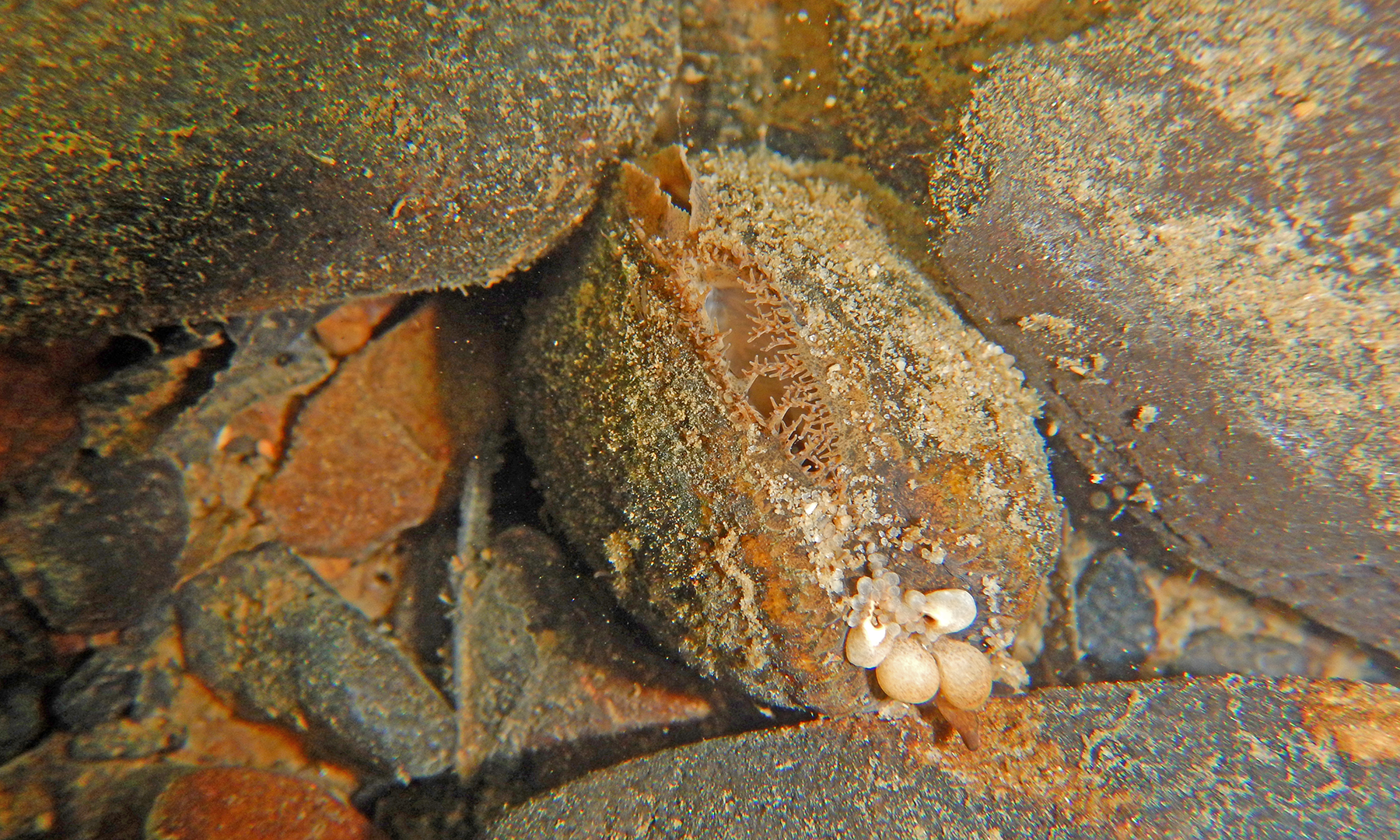
© Monte McGregor
Livers of the Rivers
As stationary creatures, mussels depend on the water around them for all their needs, including food. Mussels eat by filtering their food from the water as it passes over them. Fortunately, they aren’t picky eaters, consuming not just phytoplankton, bacteria, and algae, but in some cases also viruses, pharmaceuticals, and herbicides! In doing so, these “livers of the rivers” make the water cleaner and clearer. They also pull otherwise unavailable nutrients into the food webs of both aquatic and surrounding terrestrial ecosystems. Mussels are food for fish, birds, and mammals. Their shells also stabilize streambeds and serve as habitat for other organisms.
Freshwater mussels can also be valuable assets to scientists seeking information about aquatic ecosystems. As “indicator species,” freshwater mussels reflect the state of their environment. When they’re doing well, that’s a good sign for their surrounding aquatic system. Freshwater mussels are also “environmental logbooks,” recording changes in water quality over time2. Some species have even been used to monitor contaminants (such as pesticides or heavy metals) in waterways. As they grow, their shells even capture climate data—much like tree rings. In short, freshwater mussels are useful tools to determine the trends and conditions of the ecosystems where they reside.
North America boasts some of the most numerous and diverse mussel populations anywhere on Earth, with about 300 species (and counting, as advances in genetic studies expand our knowledge of mussel taxonomy). Most of that variety is found within the Mississippi River Basin. In some eastern river systems, you can find more mussel species in one square meter of river bottom than on the entire continent of Europe3. The Big South Fork of the Cumberland River, for instance, may have hosted as many as 70 species of freshwater mussel at one time4. Another Cumberland Plateau river, the Obed Wild and Scenic River (WSR), has a smaller assemblage of 10-12 species of freshwater mussel. Many of those are endemic to the region—not found anywhere else.
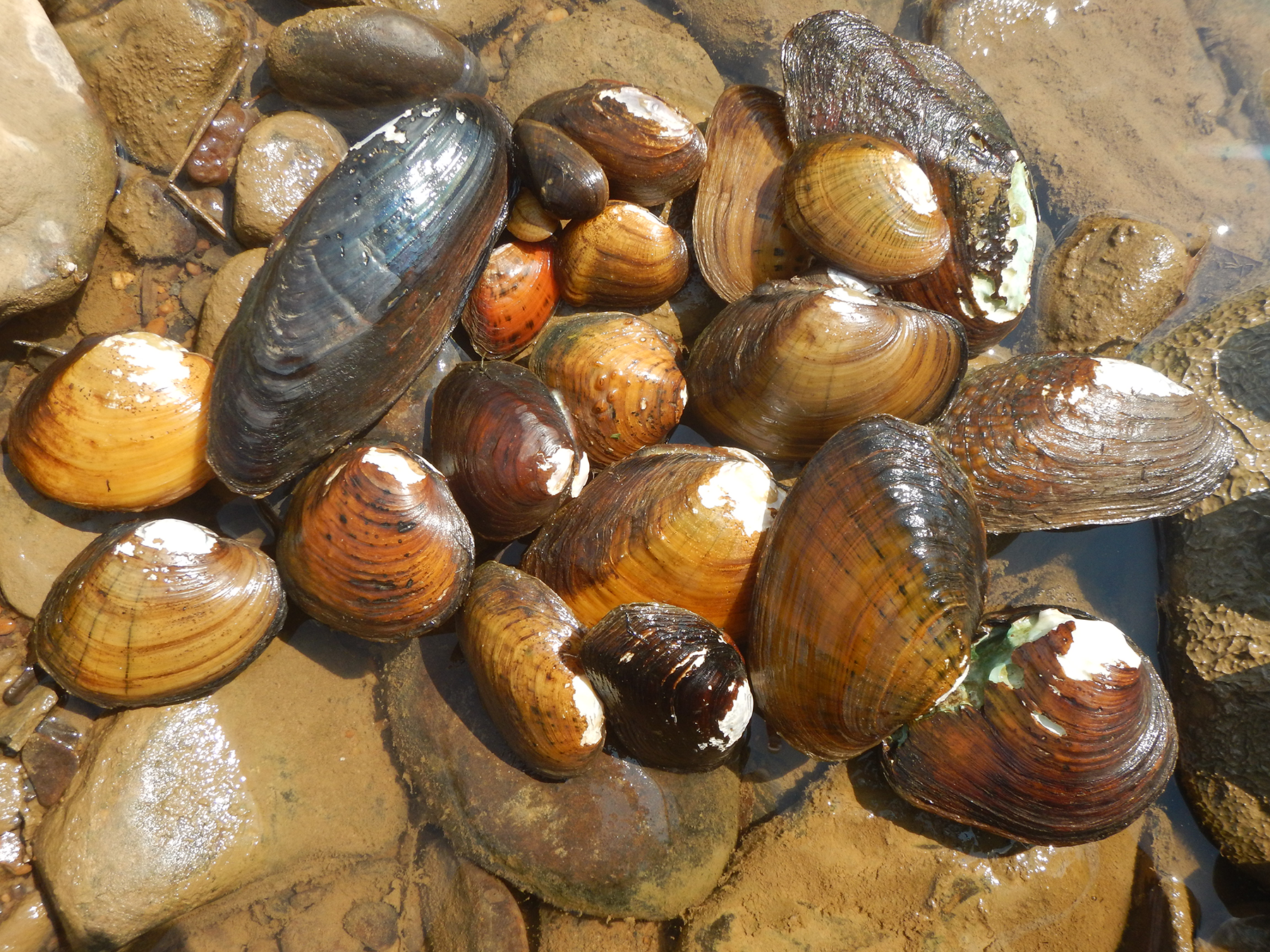
© Monte McGregor
One of the World’s Most Threatened Animal Groups
Unfortunately, freshwater mussels are in decline around the world. Thirty North American mussel species went extinct in the last century, and more than half (65%) of what remain are considered endangered, threatened, or vulnerable5. Cumberland Plateau rivers are no exception. Of the almost 70 species that could have once inhabited Big South Fork NRRA, one-third are no longer documented in the area6. Many of the species that do remain are reduced to small, isolated populations, and are themselves in danger: At Big South Fork, 14 species are listed or proposed for listing as federally threatened or endangered. Obed WSR protects one of only four remaining populations of the federally endangered Tennessee bean (Venustaconcha trabalis, formerly known as the purple bean; Villosa perpurpurea).
Mussel populations like those in the Big South Fork and Obed rivers contend with a wide range of threats. And when something happens to their environment, they can’t just pack up and find somewhere better to live. Dambuilding and droughts, which change the flow of water through the river system, can be deadly. Too little volume, and mussels have no way of eating—but too much water, too fast, might scour them downstream.
And while mussels help remove pollutants from the waterways, they also need clean water to thrive. Coal mining, Appalachia’s longtime signature industry, is associated with high concentrations of sediment and dissolved heavy metals that are toxic to mussels7. Though coal mining has been declining for decades, NPS scientists still regularly encounter byproducts of coal mining in streambed sediment. Some logging practices can also contribute heavy sediment loads to streams. Contaminants from upstream oil and gas extraction and wastewater treatment facilities could also threaten mussel populations.
Taking Action: Monitoring and Mitigation
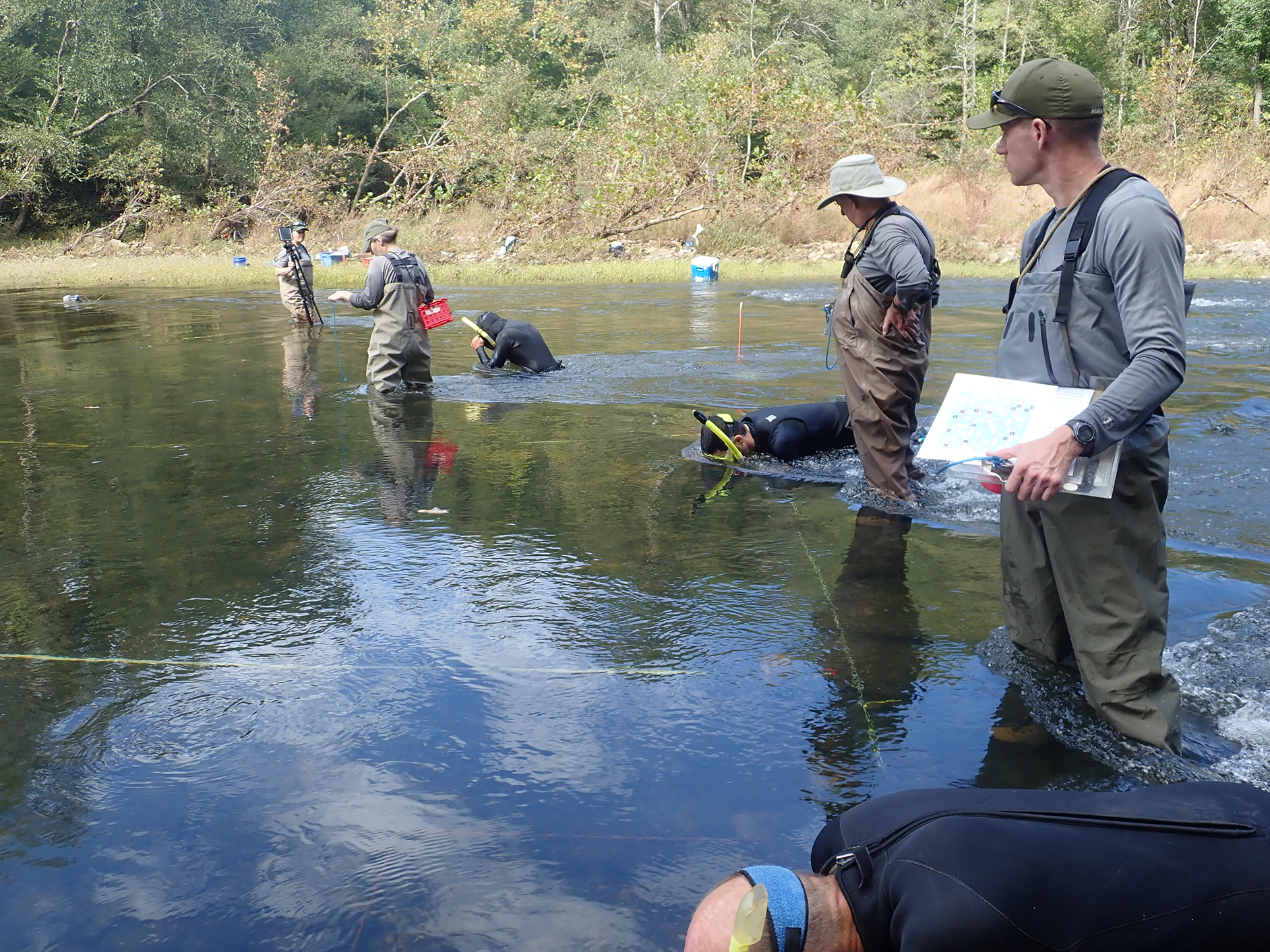
© Monte McGregor
Given the level of ecosystem services they provide, and their value as ecological indicators, park managers and scientists are working together at Big South Fork NRRA and the Obed WSR to monitor and even mitigate the decline of mussel populations.
First, they need to know what is actually happening to the parks’ mussel populations. Are all mussels disappearing, or only certain species? Is it happening everywhere, or are some sites doing better than others? Are there enough young mussels to sustain the population into the future? How steep is this decline? Is it consistent through the years, or could it be explained by one bad season? The answers to questions like these will help park managers preserve the mussel populations under their protection. Not only that, but mussels are one of the parks’ “vital signs” that indicate ecosystem health as a whole. By studying freshwater mussels, NPS staff indirectly learn about water quality and other aquatic species.
To help find the answers managers need, scientists from the NPS Appalachian Highlands Network (APHN) work with park staff to monitor mussel populations at Big South Fork NRRA and Obed WSR. That means getting up close and personal with the riverbed. First, the crew creates grids in the water with transect tapes. This helps them survey a consistent area, with no spots skipped or double-counted. Then, they split into pairs to monitor randomly selected cells within the grids. One person dons a mask and snorkel and plunges in to scan the streambed for mussels. If they’re lucky, there’s enough water to float in. When there’s not, crouching over and kneeling on the rocks to meticulously separate rocks from the merely rock-like can make for a long, uncomfortable day. When the snorkeler finds a mussel, they pass it to their partner, who records its size and species. Then the snorkeler tucks the mussel back into the substrate at its original orientation.
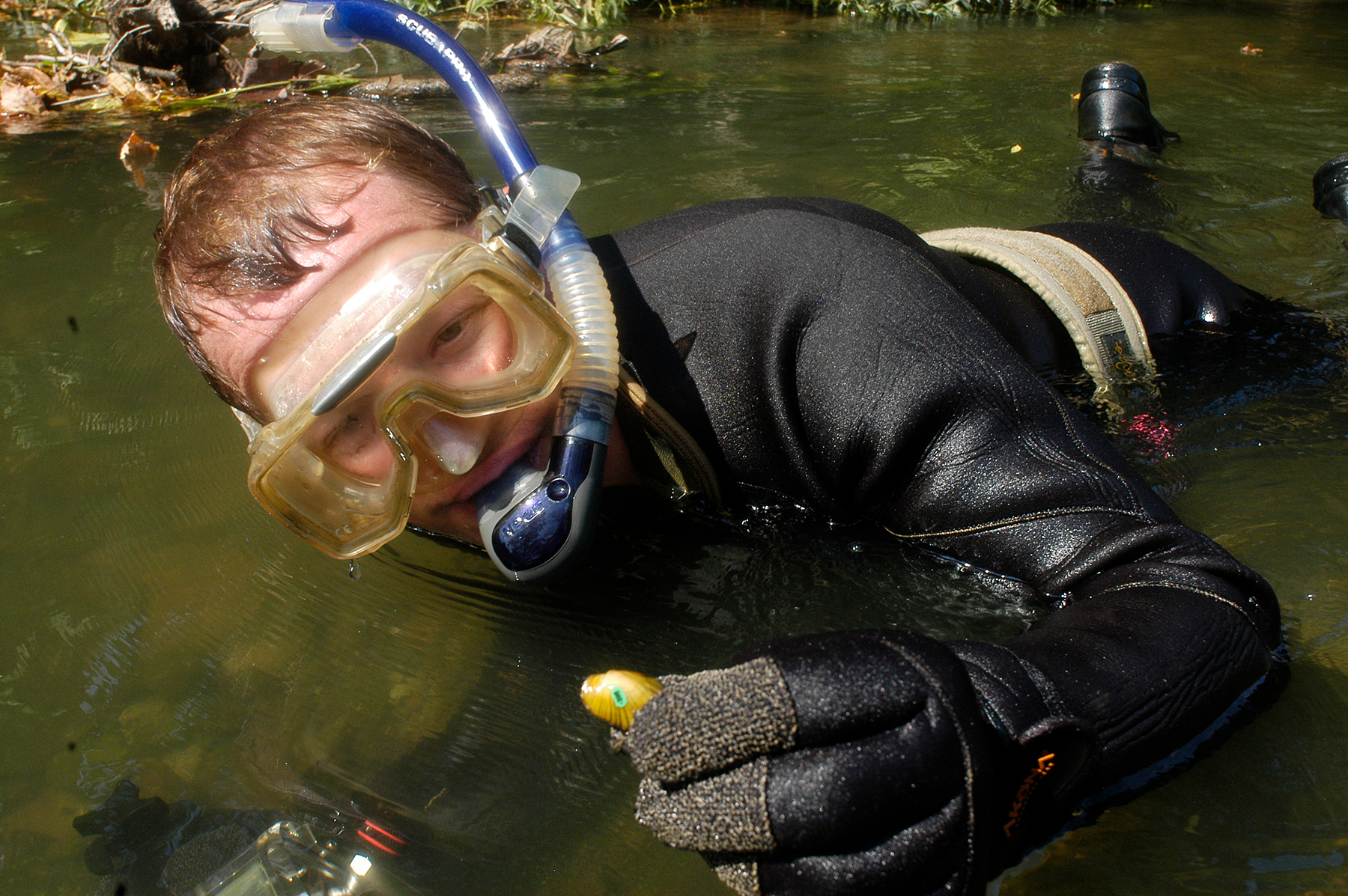
© Monte McGregor
Annual monitoring rotates across sites. That way, crews can collect a good record of conditions in a given area without disturbing the same mussels year after year. By analyzing the collected data, network scientists can determine long-term trends in species composition, age-class structure, distribution, and relative abundance of freshwater mussel populations. The network also hopes to improve understanding of the relationship between freshwater mussel communities and their habitats by comparing trends in mussel populations with changes in their physical and chemical habitat.
But APHN scientists aren’t just monitoring mussel populations. They’re also helping to boost their numbers. Working with the State of Kentucky’s Center for Mollusk Conservation (CMC), park and network staff are augmenting some of the parks’ most threatened or endangered mussel populations. At some sites, they even reintroduce mussels to their historic ranges. To do this, CMC researchers collect gravid (pregnant) female mussels from the park during the fall. They hold the mussels at hatcheries in Kentucky until March, when they surgically remove the larvae without hurting the animals. The larvae are reared on host fish or in vitro. After reaching the juvenile stage, the mussels are raised first in the laboratory, then in the hatchery. After about a year and a half, the juvenile mussels are ready to make it out on their own. Accessories are a must – the augmented mussels get marked with tags and glitter so they can be distinguished from non-augmented individuals. Finally, NPS and CMC staff release the juvenile mussels to sites identified from monitoring data. This process is phased over time, rather than all at once, to mimic natural stocking densities.
The network also supports park mussels and managers in other ways. Each spring, Appalachian Highlands Network staff help survey high-traffic horse crossings for mussels. Freshwater mussels are easily crushed by horses’ hooves, so network and park staff take a couple days each summer to comb the river bottom where horse trails cross it. Whenever they find a mussel in the danger zone, they carefully relocate it out of harm’s way. It’s a win-win for both mussels and humans, as the mussels live to see another day and network scientists get the opportunity to practice finding and identifying mussels. APHN data also help managers forge productive partnerships with other agencies and organizations. In river-centered parks, much of the watershed is often outside a park’s sphere of control. Long-term monitoring data provides park managers with a solid scientific basis for communicating their concerns and identifying priorities with stakeholders for river health.
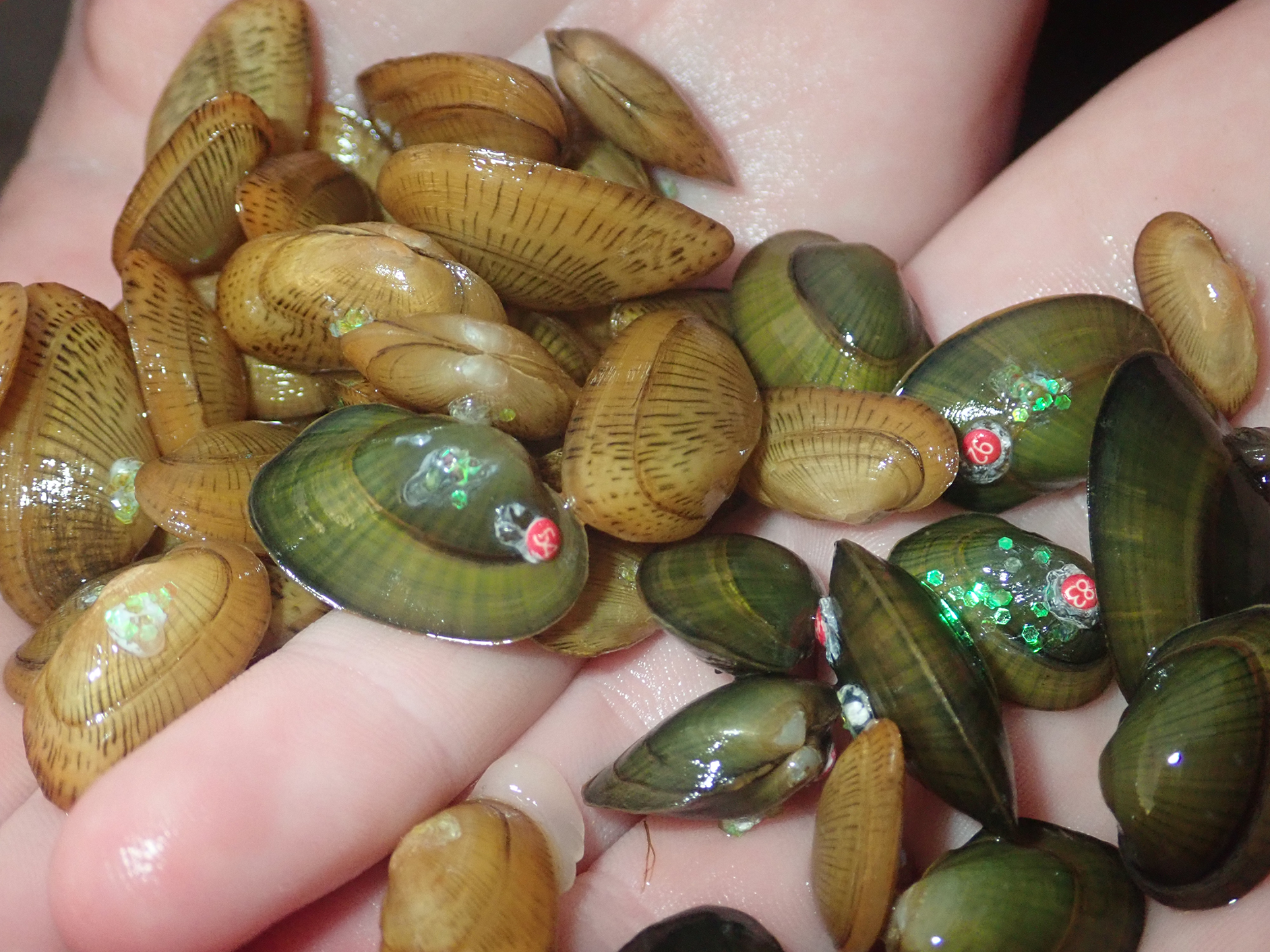
© Monte McGregor
Outlook
More than a decade after monitoring and augmentation efforts began at Big South Fork NRRA and Obed WSR, things are off to a strong start. Water quality has been improving since the late 20th century. One species (Cumberlandian combshell; Epioblasma brevidens) has been augmented to the point that it might not need any more assistance. But this is still only the beginning. The goal is to augment mussel populations to the point that they can sustain themselves. For species like the Tennessee bean, this might be their last chance.
It may seem odd for a long-term monitoring network to monitor a resource while also helping to alter its numbers. It’s a tension that network Program Manager Brian Witcher acknowledges directly: “it’s really awkward for [APHN] to monitor something where management is actively taking a role to change what’s there.” But as Witcher puts it, “if we’re the last place that can protect [these freshwater mussels], we should do everything we can.” Besides, the APHN wouldn’t be the first to simultaneously monitor and improve ecosystem health at Big South Fork and Obed. Freshwater mussels themselves have been walking that line for millennia. Now, they’re getting some help.
Research and writing by Olivia Porter, Scientists-in-Parks intern, National Park Service Inventory & Monitoring Division
1Manuel Lopes-Lima, Lyubov E. Burlakova, Karatayev, Alexander Y. Karatayev, Knut Mehler, Mary Seddon, and Ronaldo Sousa. “Conservation of Freshwater Bivalves at the Global Scale: Diversity, Threats and Research Needs,” Hydrobiologia 810 (2018): 1-14, https://doi.org/10.1007/s10750-017-3486-7
2Jeffrey D. Grabarkiewicz and Wayne S. Davis. An introduction to freshwater mussels as biological indicators. EPA-260-R-08-015. U.S. Environmental Protection Agency, Office of Environmental Information, Washington, DC, 2008.
3Wendell R. Haag and James D. Williams. “Biodiversity on the Brink: An Assessment of Conservation Strategies for North American Freshwater Mussels,” Hydrobiologia 735 (2014): 25-60. https://research.fs.usda.gov/treesearch/46062
4Monte A. McGregor. Quantitative Assessment of the Freshwater Mussel Population at Three Locations Within the Big South Fork National River and Recreation Area in Tennessee. 2012.
5Haag and Williams, Biodiversity on the Brink, 46.
6McGregor, Quantitative Assessment of Freshwater Mussel Population, 8-9.
7Jennifer Ann Guyot. “Restoration of the Endangered Cumberland elktoe (Alasmidonta atropurpurea) and Cumberland bean (Villosa trabalis) (Bivalvia: Unionidae) in the Big South Fork National River and Recreation Area, Tennessee and Kentucky” (master’s thesis, Virginia Polytechnic Institute and State University, 2005), 80, http://hdl.handle.net/10919/31358
Tags
- big south fork national river & recreation area
- obed wild & scenic river
- freshwater mussels
- mussel
- inventory and monitoring division
- aquatic animals
- mollusk
- threatened and endangered species
- endangered animal
- water quality
- bioindicator
- mussels
- aphn
- monitoring
- reintroduced species
- conservation
- appalachian highlands network
- animals
- science and resource management
- science
- ecosystem monitoring
